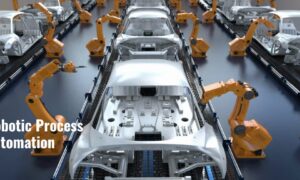Robotic Process Automation (RPA) is being hailed as a promising new technology that may one day take the place of people in routine commercial operations in order to save costs and boost productivity.
But a lot of people are still unsure of what robotic process automation is, much alone how it can automate business procedures.
In this article, we’ll examine the fundamentals of RPA—what it is, how it works, and how it could improve workflow efficiency.
RPA (robotic process automation) understanding
RPA uses software robots (or “bots”) to automate repetitive, rule-based processes that have typically been done by humans.
By interacting with different digital systems, apps, and databases, these bots simulate human behavior. RPA gives businesses the ability to improve operational efficiency, simplify procedures, and generate considerable cost savings.
Fundamentally, RPA is concerned with automating processes that are organized and standardized and that include activities like data input, extraction, manipulation, and report preparation.
By using RPA, organizations may free up precious human resources for higher-value, more strategic projects by offloading routine tasks from their employees.
How Is Intelligent Automation Different From Robotic Automation?
Together, the two technologies form RPA Intelligent Automation. They may complement one another’s advantages and aid firms in automating routine chores.
Although they are connected, they are really quite distinct from one another. Robotic process automation (RPA) is best suited for an ecosystem built on structured data, whereas intelligent automation (IA) is excellent for process optimization.
IA is the next development of RPA and automates business operations using a more comprehensive automation strategy. It provides a comprehensive approach to quickening digital transformation.
It uses analytics and artificial intelligence to automate processes and support organizations in implementing automation on a large scale. Any corporate procedure and activities may be adapted with IA.
Its capability to interface with other digital systems, tools, and contemporary technology increases the significance of this.
On the other side, RPA is one of the crucial IA pillars. RPA allows automation while also storing the data to promote interoperability and agility. It assists you in streamlining basic, rule-based procedures.
RPA bots closely adhere to set procedures to prevent complications in the future. Businesses may minimize time to market while providing top-notch goods and services with the help of the proper RPA solutions.
The following is how Robotic Process Automation is improving business efficiency.
Automates tedious procedures to lower the possibility of human error
Azi Azimi, the Chief Operating Office of CanXida believes it enhances efficiency by reducing human errors. He tells us: “As human workers are entrusted with doing menial tasks, the likelihood of mistakes in commercial processes rises noticeably.
Organizations are resorting to automation to reduce the risk of avoidable human mistakes in order to increase company efficiency. RPA implementation does this and enables businesses to reallocate staff members to departments with greater business importance.
RPA is adaptable and capable of carrying out intricate business practices. Many organizations have intricate regulations that a robot can carry out fast and efficiently without requiring human participation.
RPA’s built-in intelligence works on these procedures, freeing up workers to concentrate on more strategic and important work. This helps businesses run more efficiently.
Another advantage is that robots won’t forget to verify all of the subtle regulations that intricate company processes need, unlike human workers who often get into routines.”
Using automation’s accuracy, minimize expensive errors
RPA can lessen or even get rid of expensive errors that result in inaccurate analytics and waste resources for enterprises. Automated employees’ accuracy significantly eliminates errors from laborious, repetitive jobs.
One of the biggest advantages of this is a decreased likelihood of overlooking or entering wrong client information. Even a seemingly little error may spoil the customer experience and give them a negative impression of your business.
This danger is significantly reduced by automation, and your customer care staff will be well-equipped to provide individualized, satisfying support to your consumers.
Reduces labor shortages
RPA automation offers a dependable and valuable option while reducing labor shortages.
RPA technology implementation involves an initial investment, but it dramatically decreases the requirement for experienced workers, saving time, effort, and money on hiring.
Businesses may remove delays, improve operational efficiency, and realize long-term cost benefits by reducing human reliance via technology.
Smooth digital transformation of data from linked platforms is made possible by RPA systems’ ability to interact with current systems in a seamless manner.
They don’t need considerable code or major system changes, therefore their installation is simple and hassle-free.
By automating tedious processes, you may raise employee satisfaction
Percy Grunwald, co-founder of Compare Banks states: “Your workers’ job satisfaction will soar if they can concentrate on important duties while a robot handles the tiresome ones.
Giving your staff meaningful tasks rather than mundane, repeated ones is one of the greatest ways to keep people involved in their job, which has several advantages.
When RPA is used in the workplace, it results in happier workers who are more productive, less likely to leave their jobs, and more efficient overall.”
Improved allocation of resources and productivity
RPA frees workers from boring jobs by automating them, allowing them to concentrate on higher-value work.
As a result, there is an increase in productivity, work satisfaction, and employee engagement, and resources are used as effectively as possible.
Greater precision
Andre Disselkamp, owner of Insurancy shares: “The inherent danger of manual operations is human mistakes. By doing jobs accurately and consistently, RPA minimizes mistakes while enhancing data accuracy, compliance, and quality control.”
Cost reduction and improved effectiveness
RPA automation lowers operating expenses and the need for human work.
Organizations may simplify operations, reallocate resources to key goals, and increase productivity significantly.
Improve Digital Transformation Speed
Saj Munir, owner of Chorlton Fireworks shares: “RPA enables you to automate critical business operations and modernize old systems, enabling your company to undergo digital transformation.”



































